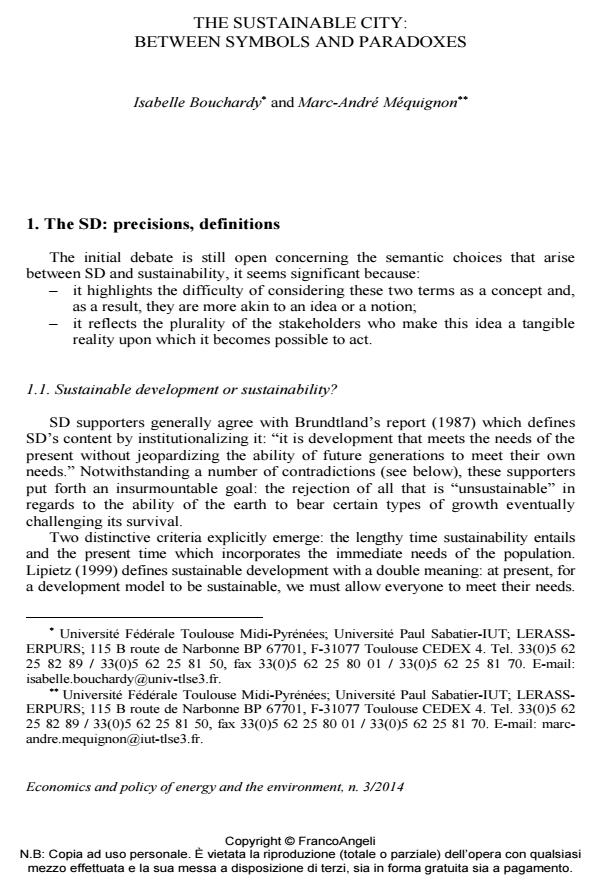The sustainable city: between symbols and paradoxes
Titolo Rivista ECONOMICS AND POLICY OF ENERGY AND THE ENVIRONMENT
Autori/Curatori Isabelle Bouchardy, marc-André Mequignon
Anno di pubblicazione 2015 Fascicolo 2014/3 Lingua Inglese
Numero pagine 14 P. 101-114 Dimensione file 608 KB
DOI 10.3280/EFE2014-003006
Il DOI è il codice a barre della proprietà intellettuale: per saperne di più
clicca qui
Qui sotto puoi vedere in anteprima la prima pagina di questo articolo.
Se questo articolo ti interessa, lo puoi acquistare (e scaricare in formato pdf) seguendo le facili indicazioni per acquistare il download credit. Acquista Download Credits per scaricare questo Articolo in formato PDF

FrancoAngeli è membro della Publishers International Linking Association, Inc (PILA)associazione indipendente e non profit per facilitare (attraverso i servizi tecnologici implementati da CrossRef.org) l’accesso degli studiosi ai contenuti digitali nelle pubblicazioni professionali e scientifiche
The ideas presented here focus on the concept of a sustainable city delimited by its habitats and revolves around main three contradictions: the heterogeneity of temporal deadlines, the inability to exceed the dimensions related to the technical specifications of buildings, an increase of global urbanization which repudiate all ecological considerations: irreversible impact that penalizes sustainable development are analyzed in regard to the paradigms of mediation and intermediation. The comparison of these different themes, from the most abstract to the extremely practical or concrete and even experimental concepts create problems a priori for some unknown reason and react poorly to analysis. The scope will be defined before attempting to apply it to the city. Then, a diachronic approach to sustainable development (SD) in relation to the city will shed light on the contradictions, but also on any aporias. Finally, part three shall conclude that the city or the urban area, as a space and building producer, will have to accept the consequences of these contradictions while generating solutions opposite to those that should be respected to meet SD criteria and in keeping the three paradoxes in perspective. In direct reference to SD, we shall try to show the consequences of the application of these various principles to a city reclassified as a "sustainable" city.
Keywords:Sustainability, city, habitat, territory, socio-ecology
Jel codes:Q17, R18, P16
- Augoyard J.F. (1979). Pas à pas. Essai sur le cheminement quotidien en milieu urbain social. Paris: Seuil.
- Baneth J. (1998). Les indicateurs synthétiques de développement. Futuribles, 231, mai: 5-27.
- Boulanger P.M. (2004). Les indicateurs de DD : un défi scientifique, un enjeu démocratique. Institut pour un DD, Belgique1, Séminaire DD et économie de l’environnement, IDRR, juillet.
- Bourg D. et Whiteside K. (2010). Vers une démocratie écologique. Paris: Seuil, Coll. La République des idées.
- Brundtland G.H. (1987). Our Common Future, Report of the World Commission on Environment and Development. World Commission on Environment and Development, August.
- Callenbach E. (1975). Ecotopia: The notebooks and reports of William Weston. Berkeley: Banan Tree Books.
- Chalas Y. (2003). L’invention de la ville. Paris: Economica, coll. Anthropos. Club de Rome (1972). Halte à la croissance. Paris: Seuil.
- Davis D. et Monk B. (sous la direction de) (2008). Paradis infernaux. Les villes hallucinées du néo-capitalisme. Paris: Prairies ordinaires, coll. Penser/Croire.
- Durkheim E. (1968). Les formes élémentaires de la vie religieuse. Paris: PUF.
- Fourastié J. (1979). Les Trente Glorieuses, ou la révolution invisible de 1946 à 1975. Paris: Fayard.
- Georgescu-Roegen P. (1995). Demain la décroissance – Entropie – Ecologie – Economie. Paris: Le Sang de la Terre.
- Godard O. (1999). Le développement durable et le devenir des villes. Bonnes intentions et fausses bonnes idées. Futuribles, 209, mai.
- Heiddeger M. (1954), Bâtir, habiter, penser. Paris: Gallimard.
- ISO 14040 (2006). Management environnemental – Analyse du cycle de vie – Principes et cadre.
- Latouche S. (2007). Petit traité de la décroissance sereine. Paris: Mille et une nuits.
- Lipietz A. (1999). Qu’est-ce que l’écologie politique? La grande transformation du XXIème siècle. Paris: La Découverte, Coll. Sur le vif.
- Méquignon M.A., Adolphe L. and Thellier F. (2012). Impact of the lifespan of building external walls on greenhouse gas index. Building and Environment. Available from: http://www.sciencedirect.com/science/article/pii/S0360132312002624?v=s5. DOI: 10.1016/j.buildenv.2012.09.020
- Mons A. (2002). Paysage d’images-Essai sur les formes diffuses du contemporain. Paris: L’Harmattan.
- Papandreou A. (1998). Externality and Institutions. Oxford: Oxford University Press.
- Platon (1990). Le Théétète – OEuvres complètes. Tome 2. Paris: Gallimard, La Pléiade.
- Robertson R. (1992), Social Theory and Global culture. Thousand Oaks: Sage.
- Sadler B. et Peter Jacobs P. (1990). Définir les rapports entre l’évaluation environnementale et le développement durable: la clé de l’avenir. In Développement durable et évaluation environnementale: perspectives de planification d’un avenir commun. Ottawa. Conseil canadien de recherche sur l’évaluation environnementale.
- Simmel G. (1989). Philosophie de la modernité. Paris: Payot.
- Vattimo G. (1989). La fin de la modernité. Paris: Seuil.
- Weber M. (1959). Le savant et le politique. Paris: Plon.
Isabelle Bouchardy, marc-André Mequignon, The sustainable city: between symbols and paradoxes in "ECONOMICS AND POLICY OF ENERGY AND THE ENVIRONMENT" 3/2014, pp 101-114, DOI: 10.3280/EFE2014-003006